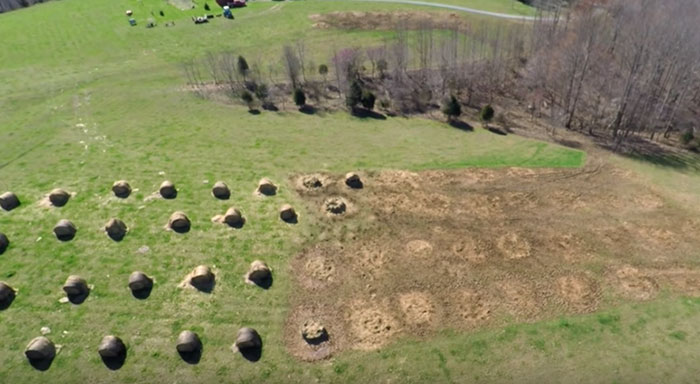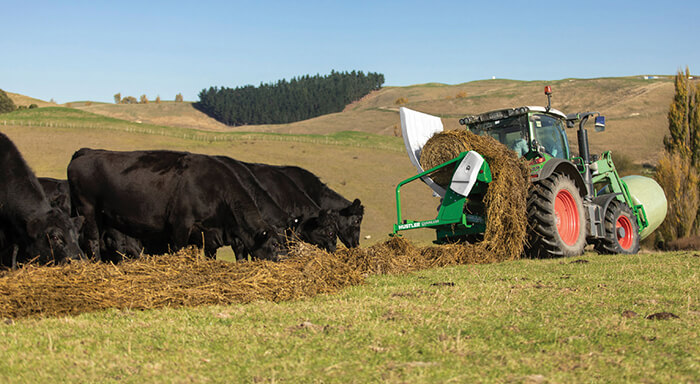How bale grazing helps to grow soil health
Winter grazing of livestock is a constant challenge, due to concerns around sediment loss, environmental issues and animal welfare. In response, some farms trial alternative solutions to winter break crops or hay rings, and feedback about bale grazing has been particularly laudatory.
What is bale grazing?
Bale grazing is a method of providing feed for livestock (mainly for beef cattle, but also more and more for dairy cattle in some parts of the world such as New Zealand) during the winter months. With this system, cattle are allowed access to bales previously placed on a field or wintering site.
 Bale grazing set up in Kentucky – By Hay and Forage Grower
Bale grazing set up in Kentucky – By Hay and Forage Grower
Bale grazing on a field is an extensive winter feeding method compared to intensive feeding in a confined area, which results in a manure pack. There are variations in the way producers set up and manage extensive bale grazing systems, but the general idea is to let the cattle graze on a hay bale (hay strings/twines being removed prior) for a short and set amount of time until they are moved to the next break.
“The perception of wintering on grass is that it will damage the soil. The concern is it will make a mess, but it is not the case if you manage it well. Most of regenerative agriculture challenges conventional systems. The hardest part is the mindset change in farmers,” Dylan Ditchfield from Freedom Acres Ltd, New Zealand said in NZ Rural Contractor and Large Scale Farmer Ground Breaker Issue 2022. Dylan and his team milk 140 cows and took part in a winter bale grazing trial organised by AgResearch scientists which started in 2018.
Dylan was originally very skeptical, but he was persuaded by Mark Anderson of Westridge Farm in Otago who has been trialling bale grazing for several years, resulting in minimal mud and success on various levels. With 15 bales per break/3 days/100 cows, Mark found that his stock ate most of the hay, they trampled about 20% into the ground and could be moved to the next break, before they cut up the soil surface.
“Hay trampled does not go to waste, adding carbon, N, P, K and other minerals. Beneficial organisms such as protozoa are stimulated by organic matter and increase the nutrient cycling process. Soil health is improved, resulting in decreased compaction, increased water infiltration, reducing runoff, increased worm numbers and improved soil structure,” Michael Cashmore explained on the website Integrity Soils.
“We did infiltration tests and soil assessments later in the season, and the difference was like chalk and cheese. The bale grazing area was superior in soil health,” Dylan continued. On Dylan’s farm, seeds from the hay germinate early with the warming compost effect. Also, as there is no lag compared to a crop after which the paddock has to be reworked and reseeded, there is no wait for it to grow.
Beyond bale grazing: the windrow feeding solution
Bale grazing offers two key advantages compared to traditional intensive winter feeding. An economical benefit first, as bale grazing can reduce the costs for labour, machinery and fossil fuels, both in the feeding of the bales and manure handling. Secondly, an environmental benefit as research has shown increased nitrogen capture in the soil profile compared to intensive feeding in a corral/paddock followed by manure spreading with equipment.
But windrow feeding can achieve this, and even more.
 Windrow feeding with Hustler Chainless system
Windrow feeding with Hustler Chainless system
Hustler Chainless feeding system can help to implement Bio-Carpeting into a feeding programme to really reap those same benefits of rotational grazing through the winter. Bio-Carpeting is a strategic feeding methodology that mimics natural grazing habits and allows to control animal traffic to reduce hay waste and pasture damage.
One of the reasons why farmers are not convinced by bale grazing is the problem of soil compaction. Even if bale grazing limits this phenomenon by restricting the number of days spent by the cattle on the plot, the soil is still somewhat damaged, especially in wet conditions.
Unlike bale grazing, windrow feeding achieves the same results but with better dispersion of hoof traffic and manure because instead of being concentrated in one small area, the herd will be fed in different parts of the pasture each day – encouraging the movement of the animals. It will ensure the nutrients from manure, urine and leftover material are uniformly deposited at acceptable rates to enhance forage growth and minimise environmental impacts on water quality.
The Hustler Chainless system is 100% hydraulically driven (no PTO) and the tractor only has to idle. Very little fuel is therefore consumed. For bale grazing, you would have had to use a tractor anyway to place the bales in the pasture.
Also, windrow feeding typically achieves less waste than bale grazing with the same benefits. For farmers who are interested in bale grazing but not ready to take the plunge because they think it creates too much waste despite the potential benefits, windrow feeding is perfect because it regenerates the soil while avoiding creating too much waste as about 95% of the forage is consumed. In addition, the forage is better spread over the whole field, which disperses the seeds and provides a larger canopy area during regrowth.
You may also like to take a look at some of these great resources:
- The Art of Sustainable Hay Feeding in a Tough Economy
- Benefits of feeding long-stem hay, especially when weaning calves
- Does it really make sense to ground-feed onto mud?
- How to deal with hay shortage in drought conditions
- Improve your pasture for free with your bale feeding routine


























